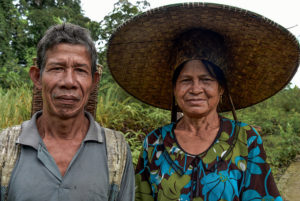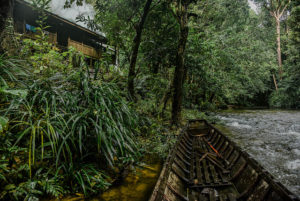
Collecting robust sex-disaggregated data on forests and climate is one thing, but analyzing it and making it available to the right players is another.
Under the umbrella of the United Nations Framework Convention on Climate Change (UNFCCC), the 48th session of the Subsidiary Body for Implementation (SBI 48) took place from April 30 to May 10, 2018, in Bonn, Germany.
An in-session workshop at SBI 48, focused on differentiated impacts of climate change and gender-responsive climate policy and action, featured a number of prominent speakers, including CGIAR Research Program on Forests, Trees and Agroforestry (FTA) gender equality and social inclusion team member Markus Ihalainen, who is also a gender researcher at FTA’s lead center, the Center for International Forestry Research (CIFOR).
The workshop was mandated in Marrakech as an element of the extended and enhanced Lima work program on gender, SBI 48 chair Emmanuel Dlamini stated in opening the workshop. The topic of the workshop was elaborated last year, in a decision that established the first gender action plan under the UNFCCC, he added.
In the workshop’s first panel discussion, speakers addressed the why and how of sex-disaggregated data in identifying differentiated impacts and informing climate policy and action. Collectively, the discussions aimed to help bring to life the gender action plan, with Ihalainen speaking specifically on sex-disaggregated data in relation to policy and action on REDD+, forests, trees and agroforestry.
Ihalainen’s presentation, based on a submission from CIFOR that was made on behalf of FTA and in partnership with colleagues from the World Agroforestry Centre (ICRAF) and Bioversity International, explained by means of background that the agriculture, forestry and other land uses sector (AFOLU) is responsible for roughly a quarter of global greenhouse gas emissions, half of which results from deforestation and forest degradation, according to the Intergovernmental Panel on Climate Change (IPCC).
In light of this, Ihalainen stated, forest- and tree-based mitigation action holds a lot of potential, but the ecosystem services provided by forests are also critical for adaptation and for reducing social vulnerability – such as by providing safety nets to communities if crops fail, offering protection against extreme weather, regulating water flows, and enhancing soil nutrient retention.
Data shows a clear division of labor in terms of ‘who does what?’, Ihalainen explained, regarding the links between gender, climate change and forest- and tree-based landscapes. This can translate to gender-differentiated perceptions and knowledge in terms of natural resources or climate change.
“Just like in the agricultural sector, there are rampant inequalities in access and control over productive assets, including land, trees, credit, information and extension services,” he said. “As well as inequalities in decision-making power.”

These inequalities result in differentiated vulnerabilities and adaptive capacities. Research illustrates that in order to ensure programmatic interventions reach both women and men:
- Gender constraints regarding time use, resources and labor need to be considered.
- We need to move beyond male and female binaries and collect and analyze more socially disaggregated data on vulnerabilities.
- We need to understand that gender relations are dynamic, and change over time.
- We need continuous efforts to collect and analyze data to understand how gender relations are affected by climate change or responses to it.
So how can sex-disaggregated data support policy and action in the forest sector?
“In looking at the forest sector, we can see that gender considerations have largely been absent in policymaking,” said Ihalainen, nothing a lack of systematic data, especially at national levels.
Many climate policies and programs in AFOLU aim to change land-use practices, for example with climate-smart agriculture, large-scale agroforestry, or land and forest restoration. These policies are often informed by a cost-benefit analysis at either community or farmer level.
“The logic is that costs incurred by communities or farming households due to this land-use change should be outweighed by immediate or future benefits, to incentivize land-use change,” said Ihalainen.
“But what’s often overlooked is that households are made up of many different members who might experience different costs or benefits from these changes. In order to accurately assess and attribute costs and benefits that are associated with different policy options, robust intra-household level data is critical.”
Thus, understanding how and by whom land is used and is critical for mitigating adverse impacts.
Mismatches between costs and benefits at the intra-household level can risk increasing inequalities within households, decreasing women’s wellbeing and serving as a disincentive for women’s participation. This shows that gender-blind policies and actions can sacrifice efficiency and long-term sustainability, while also jeopardizing gender equality and women’s wellbeing.
On the other hand, “when climate policy is gender-responsive, there is evidence to show it can help level gender equalities while generating better institutional and environmental performance,” said Ihalainen.
But these synergies cannot just be assumed, he warned. Instead they must be built on thorough gender analysis and robust data.
“If we lack an understanding of the differentiated opportunities and constraints that women and men face, we risk tasking women with saving the environment without addressing any of the structural constraints,” he added.

He admitted that tradeoffs do exist between different objectives, but that incorporating gender-specific targets and conducting thorough gender analysis can help to identify and mitigate potential tensions.
During the workshop, participants – consisting of Party delegates and representatives from observer organizations – stressed the lack of national-level sex-disaggregated statistics.
Indeed, a recent UN Women report found that only 10 out of 54 gender-specific indicators in the Sustainable Development Goals (SDGs) were produced with sufficient quality and regularity to allow for reliable monitoring on the global level. However, while it is indeed important to address challenges on the statistical front, a lack of national-level sex-disaggregated data should not hinder gender-responsive policy altogether.
“We should not think that the lack of national-level sex-disaggregated data on a number of climate-related issues means we can’t do evidence-based gender-responsive climate policy,” Ihalainen said following the event. “A lot of data and knowledge already exists, and it’s often more about establishing ways for that knowledge to inform policy. Where there are data gaps, partnerships can be established with research institutions and other stakeholders so that they can be addressed effectively.”
“National surveys are very expensive, and in some cases only occur every 10 years or so. Policy needs to move faster than that – 2030 is when we are supposed to have achieved the SDGs, not the deadline for getting our data and monitoring systems in order. So while it’s important to address national data gaps, policy making needs to focus on what we already know and make sure there are mechanisms for evidence and expertise from different stakeholders to inform policy,” he added.
“And even though you base your policies on the best data, you will never be sure your intervention will yield the anticipated results. So building in safeguards and robust, innovative monitoring systems, and allowing for adaptive learning is really critical too.”
Aside from establishing mixed-gender field teams, collecting sex-disaggregated data and capturing other forms of social difference, partnerships were identified as a key priority to ensuring that data is analyzed and validated, and fed back to policies and programs.
Many relevant guidelines already exist, including some developed by FTA partners, with Ihalainen emphasizing that the program was able to support parties in collecting and analyzing data and developing gender-responsive policies in the forestry sector – steps that will help contribute toward the gender action plan.
By Hannah Maddison-Harris, FTA Communications and Editorial Coordinator.
This research forms part of the CGIAR Research Program on Forests, Trees and Agroforestry, which is supported by CGIAR Fund Donors.











